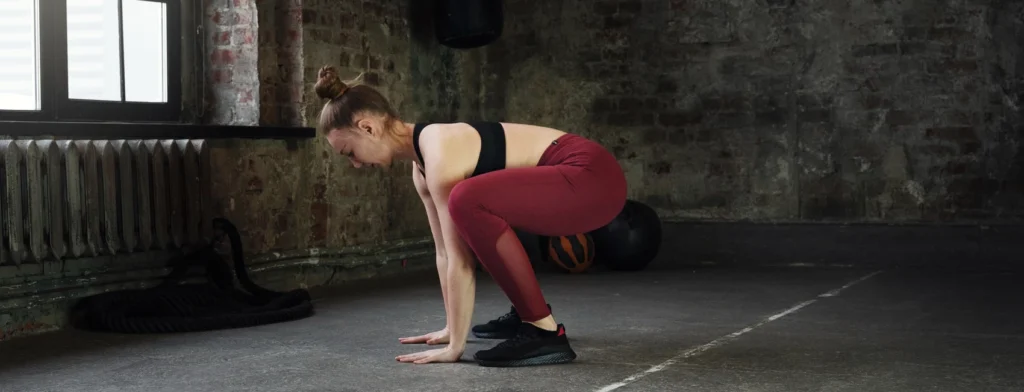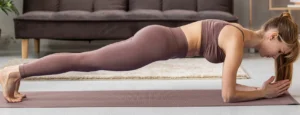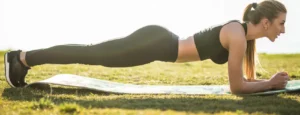Squat thrusts, also known as burpee without the jump, are a dynamic and full-body exercise that combines both strength and cardio elements. This exercise involves transitioning from a standing position to a high plank position and then returning back to standing. Squat thrusts engage multiple muscle groups and provide a challenging workout.
Squat thrusts primarily target the lower body muscles, including the quadriceps, hamstrings, glutes, and calves. The explosive movement from the squat position to the plank position activates the quadriceps and hamstrings, which are responsible for knee extension and flexion, respectively. Additionally, the gluteal muscles, particularly the gluteus maximus, are engaged to stabilize the hips during the movement.
Furthermore, squat thrusts engage the muscles of the upper body, making it a compound exercise. The muscles of the chest, shoulders, and triceps are utilized during the transition from the plank position to the standing position. The chest muscles, such as the pectoralis major and minor, are involved in pushing the body up from the plank position. The shoulders and triceps assist in the pressing movement and contribute to upper body strength and endurance.
Core muscles play a significant role in squat thrusts to provide stability and control throughout the exercise. The rectus abdominis, transverse abdominis, obliques, and lower back muscles are engaged to maintain proper spinal alignment and prevent excessive movement or sagging during the plank position.
In addition to the major muscle groups, squat thrusts also involve the muscles of the arms, such as the biceps and forearms, as they support the weight of the body during the plank position and assist in the transition. The muscles of the back, including the latissimus dorsi and rhomboids, engage to stabilize the shoulders and maintain proper posture.
Squat thrusts offer several benefits for the body, including increased muscular strength, endurance, and cardiovascular fitness. The dynamic nature of the exercise elevates the heart rate, making it an effective cardiovascular exercise that can improve overall stamina and burn calories.
Moreover, squat thrusts can be modified to suit different fitness levels and goals. For individuals looking to increase the intensity, adding a jump or a tuck jump at the end of the movement can provide an extra challenge, increasing the cardiovascular demand and engaging the muscles of the lower body even more.
Incorporating squat thrusts into your workout routine can provide a time-efficient way to work multiple muscle groups simultaneously and enhance both strength and cardiovascular fitness.
Squat Thrusts – Instructions & Steps
- Start standing with your feet flat and shoulder width apart
- Lean forward and squat to the floor
- When your palms touch the floor and your knees are near your chest, thrust both your legs backwards until the are fully extended and your toes tap the floor
- Immediately return your legs to the previous position and bring your knees towards your chest
- Stand back up and repeat
Benefits of Squat Thrusts
Squat thrusts offer a range of benefits for both your muscular and cardiovascular fitness. As with any exercise, it’s important to start at an appropriate level for your fitness level and gradually progress as your strength and endurance improve.
Full-Body Conditioning
Squat thrusts are a dynamic, full-body exercise that engages multiple muscle groups simultaneously. This makes them an efficient way to improve overall muscular strength, endurance, and conditioning. By involving both the upper and lower body, squat thrusts provide a comprehensive workout that targets major muscle groups, including the legs, glutes, core, chest, shoulders, and arms.
Cardiovascular Fitness
Squat thrusts are a high-intensity exercise that elevates your heart rate quickly, making them an effective cardiovascular workout. The continuous movement and transitions between positions increase your aerobic capacity and cardiovascular endurance. Incorporating squat thrusts into your routine can help improve lung capacity, stamina, and overall cardiovascular fitness.
Fat Burning and Weight Loss
Due to the combination of strength and cardiovascular elements, squat thrusts can contribute to calorie burning and fat loss. The intense nature of the exercise elevates your metabolic rate, leading to increased calorie expenditure during and after the workout. This can support weight loss goals and help to improve body composition.
Lower Body Strength and Muscle Development
Squat thrusts primarily target the muscles of the lower body. The squat portion of the exercise engages the quadriceps, hamstrings, and glutes, promoting lower body strength and muscle development. Regularly performing squat thrusts can help increase leg and gluteal muscle tone and strength.
Core Stability and Strength
Squat thrusts require core stabilization throughout the movement, engaging the muscles of the abdominals, obliques, and lower back. This helps to improve core strength and stability, leading to better posture, balance, and overall functional fitness.
Upper Body Strength and Toning
Squat thrusts also involve the muscles of the upper body, including the chest, shoulders, and arms. The push-up motion during the plank position engages the muscles of the chest, shoulders, and triceps, contributing to upper body strength and toning. Regular practice of squat thrusts can help improve upper body muscular endurance and definition.
Time Efficiency and Convenience
Squat thrusts are a bodyweight exercise that requires minimal equipment, making them convenient to perform almost anywhere. They can be incorporated into circuit training, interval workouts, or as part of a HIIT (high-intensity interval training) routine to maximize time efficiency and overall workout effectiveness.
Functional Movement and Coordination
Squat thrusts mimic movements used in daily life, such as getting up from the ground or transitioning between standing and prone positions. By practicing squat thrusts, you improve functional movement patterns and enhance coordination, which can translate to improved performance in sports and everyday activities.
More About Squat Thrusts
Squat thrusts are considered a compound exercise. They are a dynamic bodyweight movement that engages multiple muscle groups and joints, making them an effective full-body exercise.
During squat thrusts, the following muscle groups are engaged:
- Legs: The quadriceps, hamstrings, and glutes are involved in the squatting and jumping phases.
- Core muscles: The rectus abdominis, transverse abdominis, and obliques work to stabilize the spine and pelvis during the movement.
- Shoulders and chest: The deltoids and pectoralis major muscles are activated during the plank position.
- Arms: The triceps and muscles in the forearms are engaged when supporting the body in the plank position.
- Back muscles: The muscles in the upper and lower back help stabilize the spine and maintain proper alignment.
- Hip muscles: The muscles around the hips are activated during the squatting and jumping motions.
Squat thrusts are an excellent exercise for elevating the heart rate, improving cardiovascular fitness, and targeting multiple muscle groups simultaneously. They effectively combine cardio and strength training elements, making them a valuable addition to high-intensity interval training (HIIT) workouts or circuit training routines.
Since squat thrusts involve both lower body and upper body movements, they provide a great full-body workout and are particularly effective for improving endurance, strength, and overall body coordination.




